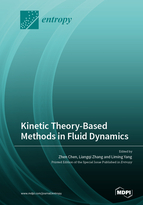Kinetic Theory-Based Methods in Fluid Dynamics
A special issue of Entropy (ISSN 1099-4300). This special issue belongs to the section "Statistical Physics".
Deadline for manuscript submissions: closed (31 August 2022) | Viewed by 19401
Special Issue Editors
Interests: Computational Fluid Dynamics; Lattice Boltzmann Method; Meshfree methods; Multiphase Flow; Fluid-structure Interaction
Interests: computational fluid dynamics; gas kinetic scheme, discrete velocity method, lattice boltzmann method; fluid-structure interaction
Special Issues, Collections and Topics in MDPI journals
Interests: computational fluid dynamics; gas kinetic scheme; discrete velocity method; lattice boltzmann method; fluid-structure interaction
Special Issues, Collections and Topics in MDPI journals
Special Issue Information
Dear Colleagues,
Kinetic theory stems from statistical mechanics established at the mesoscopic scale. In the area of fluid dynamics, kinetic theory outperforms macroscopic interpretations (represented by the Navier–Stokes equations) in theoretical generality, with no restrictions from the continuum assumption. Various methods have been developed within the framework of kinetic theory, including the lattice Boltzmann method (LBM), discrete velocity method (DVM), gas kinetic scheme (GKS), unified gas kinetic scheme (UGKS), and discrete unified gas kinetic scheme (DUGKS). These methods play unique and important roles in almost all studies of fluid dynamics.
Broader applications of kinetic theory-based methods in engineering problems are often hindered by their intrinsic limitations. In most circumstances, kinetic theory-based methods consume much larger virtual memory than macroscopic methods. Additionally, high-fidelity simulations of physical problems beyond the continuum regime are usually time-consuming. Therefore, developing and employing robust and efficient kinetic theory-based methods for various fluid dynamics problems are necessary in the research community.
This Special Issue aims to be a forum for presenting recent progress made in the very active area of kinetic theory-based methods in fluid dynamics. Papers dealing with the development of kinetic theory-related numerical schemes and their applications to fluid dynamics problems are particularly welcome.
Dr. Zhen Chen
Dr. Liangqi Zhang
Prof. Dr. Liming Yang
Guest Editors
Manuscript Submission Information
Manuscripts should be submitted online at www.mdpi.com by registering and logging in to this website. Once you are registered, click here to go to the submission form. Manuscripts can be submitted until the deadline. All submissions that pass pre-check are peer-reviewed. Accepted papers will be published continuously in the journal (as soon as accepted) and will be listed together on the special issue website. Research articles, review articles as well as short communications are invited. For planned papers, a title and short abstract (about 100 words) can be sent to the Editorial Office for announcement on this website.
Submitted manuscripts should not have been published previously, nor be under consideration for publication elsewhere (except conference proceedings papers). All manuscripts are thoroughly refereed through a single-blind peer-review process. A guide for authors and other relevant information for submission of manuscripts is available on the Instructions for Authors page. Entropy is an international peer-reviewed open access monthly journal published by MDPI.
Please visit the Instructions for Authors page before submitting a manuscript. The Article Processing Charge (APC) for publication in this open access journal is 2600 CHF (Swiss Francs). Submitted papers should be well formatted and use good English. Authors may use MDPI's English editing service prior to publication or during author revisions.
Keywords
- lattice boltzmann method
- discrete velocity method
- gas kinetic scheme and others
- kinetic theory-based flux solvers
- high-order methods
- multiphase/multiphysics flows
- micro flows
- rarefied flows
- flows in porous media
- particle-laden flows
Related Special Issue
- Kinetic Theory-based Methods in Fluid Dynamics II in Entropy (6 articles)









